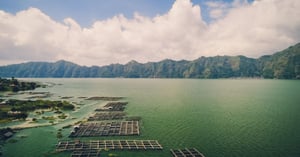THE POTENTIAL OF SEAWEED FARMING:A RISING TIDE
| Chief Carbon Reduction Scientist, Dr Torill Bigg, has written an article for ecomagazine on ‘The Potential of Seaweed Farming: A Rising Tide’. |
DR TORILL BIGG |
EXCERPT
The farming of seaweed embraces and retains these environmental benefits while providing eco-friendly products, employment, and economic activity. Globally, the intensity of seaweed farming has accelerated rapidly this century (Food and Agriculture Organization). Yet the full potential of seaweed is far greater still. This is especially true in Europe, which has only 0.8% of worldwide seaweed production.
European countries face complex and simultaneous challenges such as climate change, sea-level rise, economic instability, and unsustainable fishing practices. Against this backdrop, it holds great promise, offering a sustainable, multifaceted approach to tackle these issues. Leveraging the benefits of farming would help stimulate local economies and contribute to environmental protection and climate change mitigation.
Carbon stored in marine and coastal ecosystems is known as Blue Carbon. Seaweed farms, as a part of these ecosystems, can play a significant role in carbon sequestration. Because seaweeds grow rapidly and have significant photosynthetic activity, combining light and carbon to fuel that growth, they absorb substantial amounts of carbon dioxide, and lock it into a solid form. This can then be harvested or allowed to sediment into the seabed. Seaweeds are 20 times more effective at this than land plants. Several countries, including China, Indonesia, and the Philippines, have made seaweed-based carbon sequestration an integral part of their strategies for climate change mitigation.
Maybe in part because of this strategy, there is a greater volume of seaweed collected in farming in Asia than in Europe. European schemes however are on the rise. In the UK seaweed businesses doubled between 2016 and 2023. For it to contribute an appreciable difference to carbon emissions requires a massive scale-up from pilot projects to kilometer-scale farms. This would entail the welcome necessity of investment in people’s skills and knowledge and increased funding for seaweed businesses. Ongoing research into the ecosystem benefits and possible negative consequences of large-scale seaweed farms is also needed to ensure that large farms do not inadvertently harm local marine fauna and flora or the local communities too. And a balance would need to be found in order to deploy the maximum benefit from seaweed farming in removing carbon from the atmosphere while stimulating the economy.




-1.jpeg?width=200&height=244&name=Tunley%20Headshots%20(17)-1.jpeg)